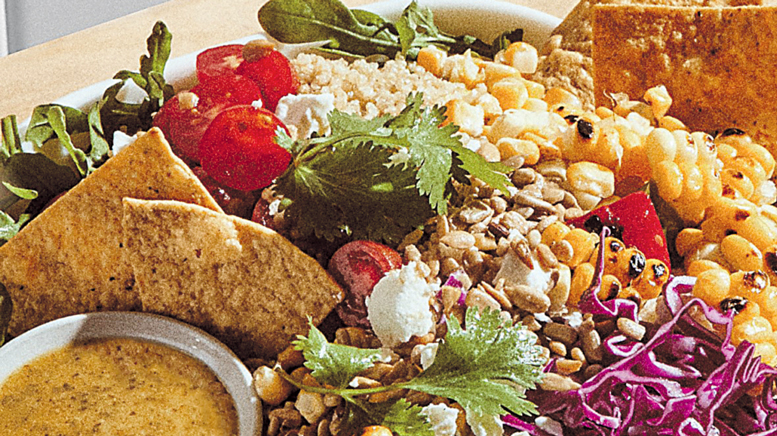Fast Food Chains Put More Produce on the Plate
April 23, 2024 | 8 min to read


PHOTO COURTESY SWEET GREEN
The freshness of the produce is a good indicator of the quality standards of an individual restaurant.
Originally printed in the March 2024 issue of Produce Business.
The freshness of its tomatoes is one of the key factors determining whether or not a franchisee of Jersey Mike’s Subs gets the green light to expand, says Michael Manzo, chief operating officer of the Manasquan, NJ-headquartered quick serve restaurant (QSR) chain with 2,500-plus locations nationwide.
“The freshness of the produce, the lettuce, tomatoes and onions, for example, is a good indicator of the quality standards of an individual restaurant,” says Manzo. “For over 40 years, we’ve washed, sliced, and diced all our produce in-house and it’s a part of the brand we stay true to.”
Fresh produce isn’t typically the first thing associated with QSRs, or even fast-casual concepts.
However, most actually do incorporate fruits and vegetables consistently across their menus, “even the most die-hard burger and chicken joints,” says Nelia Alamo, vice president of marketing for the Markon Cooperative Inc., in Salinas, CA. “Potatoes and onions feature prominently, but other ingredients such as avocados, tomatoes, salad mixes, bell peppers, corn, and fresh juices are integral to menu items.”
A good example is Chipotle Mexican Grill, a 3,300-plus fast-casual restaurant chain based in Newport Beach, CA. Chipotle purchased some 332 million pounds of produce in 2022, according to the chain’s 2022 Sustainability Report. Top items, in descending order of quantity, were avocados, tomatoes, onions, romaine, lime, lemon, jalapeno, bell peppers, cilantro and supergreens (romaine, baby kale and baby spinach).
Another great example is Jersey Mike’s Subs. Manzo says that the chain buys and uses 100 million tomatoes a year sourced from 14 repackers across the country; 1,400 acres worth of iceberg lettuce grown by longtime family farms in California and Arizona, and 10 million pounds of Spanish onions from three growers in the Idaho-Eastern Oregon region.
MENU EXAMPLES ABOUND
FOR STARTERS: There are beverages. Last summer, Wendy’s added to its menu of Dave’s Craft Lemonades by offering its Blueberry Pomegranate Lemonade. The drink is made with real fruit juices and purees. As for salads, the Dublin, OH-headquartered burger chain with over 7,000 restaurants worldwide, offers four produce-rich salads as regular menu items in the fall. The chain also brought back its seasonal Summer Strawberry Salad last year.
PIZZA: Pizza is the ideal platform for produce and some fast-casual chains have taken full advantage. The Super Shroom Pizza, which starts with a mushroom pesto base topped with mozzarella, pork sausage, fresh mushrooms, fresh spinach, and a rosemary garnish, served as an LTO last winter for MOD Pizza, based in Seattle, WA, with nearly 600 locations in the U.S. and Canada.
In September, the Mega Mushroom Pizza, with triple the mushrooms over mozzarella and sauce, was listed as the “What’s Hot” monthly value special by Blaze Pizza, a Pasadena, CA-headquartered chain with 300-plus locations. It’s no wonder mushrooms were the topping of the year, appearing on 9% more pizzas than a year ago, according to the 2023 Slice of the Union report from Slice, a New York-based technology platform powering the nation’s largest network of pizzerias.
SUBS, BURGERS & SANDWICHES: Mushrooms have made their way into handhelds as well.
“From subs to burgers, mushrooms deliver flavor, boost umami, and provide satisfying ‘meatiness’ in a familiar, well-loved package, even a plant-based version,” says Pam Smith, foodservice consultant for Lee’s Summit, MO-headquartered The Mushroom Council.
In the summer of 2021, Jersey Mike’s Subs debuted its Grilled Portabella Mushroom & Swiss hot sub.
“It’s become so popular that we also added a Portabella Cheesesteak and Portabella Chicken Cheesesteak to our menu,” says Manzo.
Last March, diehard mushroom lovers met their match with the new Fried Mushroom Buford LTO at Checkers and Rally’s, an 800-plus location chain of double drive-thru restaurants owned by Checkers Drive-In Restaurants, Inc., in Tampa, FL. Ingredients include two large beef patties topped with Swiss cheese, crisp batter-fried baby portobello mushrooms, a savory mushroom sauce, and caramelized onions on a toasted bun.
“The idea developed as a broader appeal barbell strategy to offer their Mushroom Swiss Burger, made with a rich mushroom sauce, as a value offering and then the Buford to appeal to the higher dollar occasion customer. Unexpectedly, customers started asking for fried mushrooms as a side dish. That was a shock since we are known for our fries,” says Andrew Ruga, senior research and development manager and corporate chef. “But it’s now created both a value and more premium burger offering, plus a side dish on the menu.”
Ruga says the company is working on another item that will feature fresh produce and be introduced in 2024.


PHOTO COURTESY CALIFORNIA AVOCADO COMMISSION
Fresh California-grown avocado has starred in both seasonal burgers and as additional topping selections at Super Duper Burgers, a 15-location fast food burger chain headquartered in San Francisco, CA. There’s a call-out on the menu that says, “We proudly serve California-grown avocados.”
“Fresh produce is a key component of our menu. Four times a year, we create a new seasonal item that almost always leverages fresh, in-season produce,” says Edmundo Oñas, vice president of operations. “Our guests enjoy avocado as an add-on item to their burgers, salads and sandwiches, and we love being able to source ingredients locally when we can. It’s always helpful when produce groups like the California Avocado Commission remind us of the crop timing, market conditions, and even menu suggestions. Getting those details right helps us be successful.”
Fans also love the Sooo Cali, a hot dog in a bun with California-grown avocado in season, plus tomato, fried onions, and a spicy basil aioli, served at Dog Haus, a fast-casual hot dog concept founded in Pasadena, CA, with 50-plus locations.
“We love to support our partners like the California Avocado Commission and their growers in promoting our menu offerings that feature their produce. Using locally grown produce falls right in line with our brand’s quality statement,” says Marilyn Perkins at Champion Management, which represents Dog Haus.Based on the Irving, CA-headquartered CAC’s Patron Preference research, almost 90% of consumers perceive dishes using California Avocados to be fresh and high quality, says Terry Splane, vice president of marketing. “Over half of consumers also say they would probably or definitely pay more for a menu item with California Avocados.”
For something a little different, blueberries starred in the Blueberry BBQ Ringer as a new flavor for Spring 2022 at Buffalo Wings & Rings, a Cincinnati, OH-based sports restaurant franchise with 80 locations across the globe. The chicken breast sandwich is served with Blueberry BBQ sauce, spicy slaw, candied pecans and dried cranberries.
“We’re seeing blueberries show up in sauces and salad dressings, which makes for an approachable and familiar, yet still innovative twist on classics like balsamic vinaigrette and barbecue sauce. Nearly two-thirds of QSR patrons (63%) agree that blueberries brighten up the flavor of sauces and dressings, so this is an obvious choice for operators in the space,” says Kasey Cronquist, president of the U.S. Highbush Blueberry Council, in Folsom, CA.
Cauliflower is also new on the fast-food scene. Earlier this year, Chick-fil-A, an Atlanta, GA-headquartered chain with 2,800-plus locations, began testing its Cauliflower Sandwich at restaurants in three markets in Colorado, North and South Carolina. The sandwich is made with a tender filet cut from a whole head of cauliflower, which is prepared similarly to the original Chick-fil-A Chicken Sandwich.
Cauliflower is one of the fastest-growing fruits and vegetables on restaurant menus, according to Datassential, a Chicago, IL-based market research firm, with a 12.7% penetration in all restaurants, 7% growth in the last year, and 35% growth over the last four years.
In the No. 1 position of produce on fast food menus is Elote, with a scratch-the-surface menu listing of only 1.4%, but up 13% over the last year and a whopping 491% over four years.
The Elote Bowl, starring roasted corn and veggies like peppers, cabbage, tomatoes, cilantro and arugula, started as a summer season offering and now has joined the menu full-time at Sweet Green, a 221-unit fast-casual chain that originated in Los Angeles, CA. Another new menu item featuring fresh produce was a summer LTO, the Peach and Goat Cheese Salad, with the peaches sourced from Frog Hollow Farm, in Walla Walla, WA.
“One of our biggest differentiators as a brand is our end-to-end supply chain where we build direct relationships with our growers, farmers and partners that we trust. We look to more than 200 sustainable farmers, producers and distribution partners to supply us with fresh produce every day. Our growers dedicate year-round acreage on their farms for our core ingredients and create regional programs for our seasonal LTOs,” says Jenny Seltzer, communications manager, Sweet Green.
SWEETS. Walnuts have been the most popular on QSR menus as inclusions in salads, desserts, and bread and baked goods, says Robert Danhi, chef-in-residence for the California Walnut Board & Commission, in Folsom, CA. “Walnuts provide texture, a rich flavor and are a nutritional powerhouse.”
Burgerville, a 40-unit fast-casual burger chain based in Vancouver, WA, offers an Apple Crumble Sundae LTO in September using walnuts as an ingredient. A recurring seasonal LTO at Au Bon Pain, a 180-plus fast-casual chain headquartered in Richardson, TX, is the Pumpkin Blonde, also made with walnuts.
THE HEALTH HALO MARKETING ADVANTAGE
Eating too much fast food is linked with heaping helpings of calories, fat and sodium, all nutrients that, when consumed in abundance, are linked to chronic diseases. This can be easy to do, considering two in three Americans consume fast food at least once a week. Fresh produce contains a minimum amount of these nutrients, plus puts disease-preventing vitamins and minerals on the plate.
“Adding fresh produce to the menu brings a health halo to any operation,” says Amy Myrdal Miller, MS, RDN, FAND, founder and president of Farmer’s Daughter Consulting Inc., in Sacramento, CA. “But price is an important consideration. Inflation has caused both operators and diners to be cautious.
“Operators are paying more for labor in many parts of the country. Meanwhile, consumers are reticent to spend their hard-earned money on an item that may not deliver great taste or great value. However, some insights suggest some consumers are willing to trade up for a premium experience. Offering a burger or sandwich with butter lettuce versus iceberg is an example of this. There is also a lot of consumer support for local, so if an operation can promote local sourcing of a produce item on their menus, that will attract the attention of some diners.”

